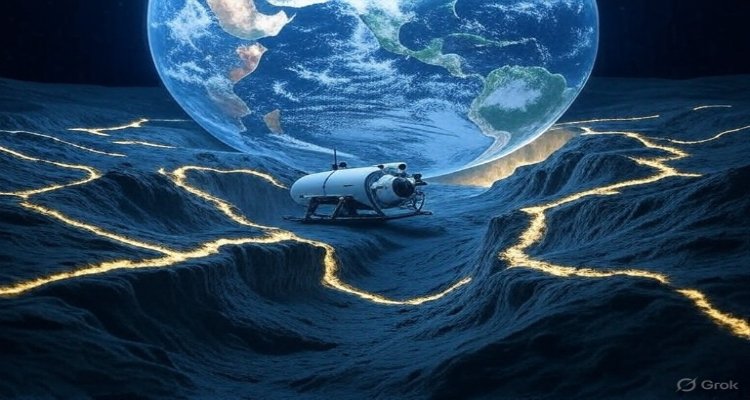The Missing Oceans: What Lies Beneath Earth’s Unmapped Seas
Over 80% of Earth’s oceans remain unexplored. Discover why vast stretches of our seas are still unmapped, what lies beneath, and why it matters for humanity’s future.
Introduction: The Greatest Unknown on Earth
When we look up at the night sky, telescopes can peer millions of light-years into distant galaxies. Yet, beneath our very feet lies a mystery far closer and far more tangible—our oceans. Despite covering more than 70% of Earth’s surface, a staggering 80% of the ocean floor remains unmapped, unobserved, and unexplored. This hidden frontier continues to hold secrets that could redefine our understanding of climate, ecosystems, and even human survival.
Context & Background: A Vast Blue Unknown
The ocean has long been the lifeblood of human civilization, powering trade routes, feeding nations, and regulating climates. But while satellites have mapped the surface of Mars and Venus with remarkable precision, Earth’s seabeds remain largely in shadow.
The reasons are practical as much as technological: surveying deep waters is costly, slow, and technically challenging. Extreme pressures in the deep sea crush traditional equipment, while vast distances make comprehensive mapping a monumental task. For comparison, only one-fifth of the seafloor has been mapped with modern sonar technology, leaving the majority charted only through rough satellite data.
Historically, major oceanic discoveries have stunned humanity. From the detection of hydrothermal vents in the 1970s—teeming with life in places once believed inhospitable—to the discovery of plastic microfibers in the Mariana Trench, the unexplored ocean continues to rewrite science textbooks.
Main Developments: Why the Missing Oceans Matter
Climate and Environmental Knowledge
The oceans are Earth’s greatest carbon sink, absorbing nearly one-third of human carbon emissions. Without high-resolution seafloor mapping, scientists struggle to model how ocean currents move, how heat circulates, and where carbon is stored. This missing knowledge hampers accurate climate forecasts.
Biodiversity and Medicine
Every trip into the deep brings new discoveries. From bioluminescent species to microbes thriving in toxic environments, these organisms inspire breakthroughs in medicine, biotechnology, and materials science. Yet without systematic mapping, countless species remain hidden—and vulnerable to extinction before they’re even known.
Natural Hazards
Earthquakes and tsunamis often occur along undersea fault lines. Without detailed seafloor surveys, disaster prediction systems lag behind their potential. Improved ocean mapping could save thousands of lives in vulnerable coastal regions.
Untapped Resources
From rare earth minerals essential for renewable energy to untapped geothermal and marine genetic resources, the seafloor harbors immense potential. However, this raises ethical questions about balancing exploration with conservation.
Expert Insight & Public Reaction
Dr. Ana Ribeiro, a marine geophysicist at the University of Lisbon, explains:
“We know more about the topography of Mars than our own oceans. The technology exists, but what is lacking is coordinated global effort and funding to bring these maps to life.”
Public curiosity echoes this sentiment. Social media conversations surrounding underwater mysteries—such as the “unmapped abyss” or UFO-like sonar anomalies in the Baltic—often trend globally, reflecting humanity’s fascination with the idea of hidden worlds beneath the waves. Many citizens voice a sense of urgency: if the oceans are key to understanding and protecting our planet, why is exploration still lagging?
At the same time, environmental groups caution against a rush to extract seafloor resources without fully understanding ecological consequences. “Exploration without conservation is just exploitation,” warns the non-profit group Ocean Legacy.
Impact & Implications: What Happens Next?
Several global initiatives are attempting to close the ocean knowledge gap. The Seabed 2030 Project, launched in 2017, aims to create a complete map of the ocean floor by 2030 using sonar-equipped ships and autonomous underwater vehicles. Nations have also begun strengthening maritime research programs as ocean security, climate adaptation, and food supply grow more urgent in policy discussions.
Implications reach far beyond science:
-
Climate resilience: Better models will strengthen global responses to warming seas.
-
Food security: Mapping ecosystems will safeguard fisheries for billions dependent on marine protein.
-
Disaster preparedness: Improved fault-line data could prevent catastrophic loss of life.
-
Ethics of exploitation: Policymakers will face decisions on whether to mine seabeds or preserve them as protected planetary commons.
Conclusion: Charting the Blue Frontier
The missing oceans are not just a scientific mystery—they are a reminder of how much remains unknown on our own planet. With the seas regulating climate, sheltering life, and holding resources critical to humanity’s future, the costs of ignorance are too high. Charting Earth’s unmapped waters is not merely an exploration project; it’s a survival strategy.
As funding, technology, and global cooperation grow, the next decade could see one of the most ambitious undertakings in human history: revealing what truly lies beneath Earth’s vast, unmapped seas. The final frontier might not be space—it might be the depths of our own oceans.
Disclaimer: This article is based on research-driven knowledge and expert opinions. While it highlights ongoing initiatives and scientific perspectives, ocean exploration remains a developing field with new discoveries emerging regularly.











